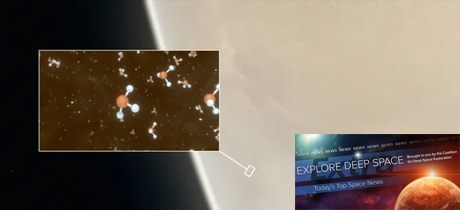In Today’s Deep Space Extra… NASA completes the reorganization of its Human Space Exploration and Operations Directorate. Space weather bill is passed by Congress. Some scientists caution past flows of acidic fluids on Mars may have erased evidence of microbial life. Commerce on the International Space Station (ISS) expands with agreements with a global cosmetics firm and a reality television show that will send a winning contender to the Station for a visit.
Human Space Exploration
NASA human spaceflight directorate completes reorganization
SpaceNews.com (9/17): NASA has completed a reorganization of the Human Space Exploration and Operations Directorate. Long anticipated, the changes in personnel are responsible for developmental and operational activities that range from the International Space Station (ISS) to plans to return human explorers to the lunar surface in 2024. Kathy Lueders, heads the directorate, a post she was appointed to three months ago.
Scientists: We could build Mars shelters out of insect polymers and Martian soil
Futurism.com (9/17): Chitlin is a plentiful polymer found on Earth. A microorganic byproduct, it is a polymer that on Mars could be fashioned into habitats using a 3-D printing technology, according to a research effort published in the journal PLoS ONE.
Space Science
Space weather bill passes Congress
Parabolicarc.com (9/17): Legislation that has passed both houses of Congress, PROSwift, would establish an intergovernmental space weather working group to better monitor and forecast major space weather events, including solar activity. The White House Office of Science and Technology Policy (OSTP) would oversee. NOAA, NASA, the Department of Defense (DoD), National Science Foundation (NSF), Department of Interior and others, including a 15 member advisory panel, would participate.
James Webb will look for signs of life on planets orbiting dead stars
Universe Today (9/17): A Cornell University led research effort has concluded that the NASA led James Webb Space Telescope (JWST), due to launch on October 31, 2021, is suited to study planetary bodies orbiting white dwarf stars, which are stars like that sun that have exhausted their fuel and exploded. The science team makes their case that planets around an inactive star could be easier to observe for evidence of biomarkers according to the report published in the Astrophysical Journal Letters.
Hubble captures crisp new image of Jupiter and Europa
Hubble Space Telescope (9/17): New imagery from the now 30-year-old Hubble Space Telescope shows new activity at Jupiter around the Giant Red Spot and the ice and ocean covered moon Europa, which may host habitable environments.
Study shows difficulty in finding evidence of life on Mars
Phys.org (9/15): Efforts now underway by NASA and its European Space Agency partner to return samples of Mars to Earth for analysis seeking evidence of past life on Mars could be complicated. A flow of acidic fluids on the surface of the Red Planet may have destroyed that evidence of past biological activity, according to a study by Cornell University scientists published in the Nature journal Scientific Reports.
China is quietly preparing for November launch of the Chang’e-5 lunar sample return mission
SpaceNews.com (9/17): China appears to be preparing for a late November launch of the Chang’e 5 lunar sample return mission, something not achieved since the 1970’s. The destination is a volcanic formation on the Moon’s near side, where the mission spacecraft are to collect about 2 kilograms of material for return to Earth.
Other News
NASA and Energy Department step up cooperation
SpaceNews.com (9/17): During a University of Tulsa hosted roundtable on Wednesday, executives from NASA and the Department of Energy discussed their intentions to work closely on future efforts to improve photovoltaics, the technology for solar array electricity generation; a ground observatory capable of assessing Near Earth Objects with an Earth impact potential; and lunar science. Already, the two agencies are working on technology for a nuclear power source for the surface of the Moon.
NASA astronauts have a new task: Make videos of Estée Lauder products
Coalition Member in the News – Northrop Grumman
CNN (9/17): As part of its effort to help nurture new low Earth orbit commercial activity, NASA will assist Estee Lauder by filming a skin care product in the absence of gravity aboard the International Space Station (ISS). It is part of a Space Act Agreement between NASA and the company. In the future, NASA intends to invest about 5 percent of the time astronauts spend working aboard the orbital outpost to commercial activities. Earlier this year, NASA Administrator Jim Bridenstine confirmed that actor Tom Cruise plans to film a movie aboard the Station.
A reality TV show wants to send its winning contestant to the International Space Station (ISS) in 2023
Coalition Member in the News – Axiom Space
CNBC (9/17): Space Hero, a television production company, announced Thursday that it plans to launch the winner of a new reality television show to the International Space Station (ISS) in 2023. The voyage will be managed by Axiom Space, of Houston, which has an agreement with NASA to conduct commercial activities aboard the orbiting lab, including the launch and berthing of one or more modules beginning in 2024. NASA plans to transition the oversight of low Earth orbit activities to the commercial sector in order to turn its human exploration focus to deep space. NASA would become one of many customers flying aboard commercial space stations as it establishes a sustainable human presence on the Moon and prepares for expeditions to Mars.
Is Earth-Moon space the U.S. military’s new high ground?
Space.com (9/17): Evolving U.S. military doctrines suggest the nation’s air, land and sea national security interests are about to expand out to the Moon as NASA leads international and commercial partners in an effort to return to the lunar surface with human explorers in 2024 and establish a sustainable presence by 2028.

